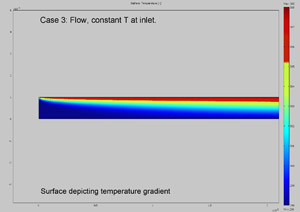The effect of the Entry Region on Thermal Field Flow Fractionation Nick Cox
Achieving the separation and purification of large or delicate molecules, such as polymers or DNA, can be difficult using conventional techniques, which may require introducing such compounds to extreme temperatures or pressures. Ergo, developing techniques to achieve high purity final products under mild conditions has obvious practical purposes. Micro thermal field-flow fractionation (TFFF) is a technique utilizing the interactive effects of temperature and concentration gradients on molecular diffusion, whereby large molecules can be separated with high purity by applying a very small temperature gradient (on a range of the order of 1 to 10 K cm-1) to a fluid flowing through a very thin channel. Our previous work focused on an investigation into the potential use of computational techniques to model TFFF devices. Because previous attempts assumed a fully-developed thermal gradient at the channel inlet, in this paper, we seek to build on this work by investigating the effect of a thermal entry region on the results of our computer model, in addition to fluid flow through the channel. |
